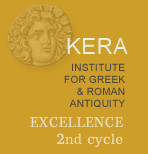Main Site . İbecik
46. Epitaph of Herakleon and his family
![]()
|
Ἡ͜ρακλέων ἑαυτῷ καὶ γυναικὶ αὐτοῦ Ἐπιχαρίδι καὶ τέκνοις αὐ– τῶν· ἑτέρῳ δὲ οὐδενὶ ἐξὸν ͜εἶναι θάψαι τινὰ ἐν͜͜τ͜͜ῇ͜͜σορῷ ταύτῃ ἐπὶ ἀπο– δώσει τ͜ῇ πόλει (δηνάρια) ,α. |
Herakleon for himself and his wife Epicharis and their children. No one else will be allowed to bury someone in this coffin, or he will pay the city one thousand denarii.
Sarcophagus chest with relief, seen and documented in İbecik "in front of the main fountain" by Bean and Schindler in 1966. İbecik no longer has old springs or fountains.
Height: not available; length: 128 cm; depth: 71 cm; letters: 3.5 cm.
Schindler 1972, no. 19 (pl. 3.17: squeeze); BullÉp 1973, no. 461; Milner 1998, p. 3, no. 2.3. Strocka 1978, p. 888, no. 30; Işık 1993, p. 11; SEG 43 (1993), 968.
L. 1 : Ἡρακλέων is widespread in Attica and mainland Greece. In Asia Minor, the name appears to be somewhat more common in Pisidia, particularly in Termessos (cf. Schindler, loc. cit.). It is attested in Cibyra, IK Kibyra I 90 and 365. The name Ἐπίχαρις (LGPN: Ἐπιχαρίς) is rather rare. There are some scattered examples from Greece, and a few from Lydia, Phrygia, Lycia and Pamphylia.
L. 2 : ἐπί stands for ἐπεί, because he will pay...
The sarcophagus appears to be of hellenistic date on stylistic grounds (Strocka), but there has been considerable disagreement concerning whether it should be assigned to the third or the first century BCE. The inscription however dates to the Imperial period and must be assigned to secondary use (SEG 43 [1993], no. 968).

